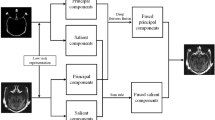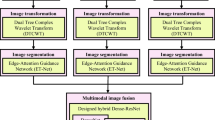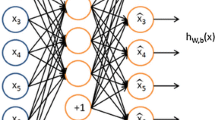Abstract
Recently, deep learning has high popularity in the field of image processing due to its unique feature extraction property. This paper, proposes a novel multi-layer, multi-tier system called Multi-Layer Intelligent Image Fusion(MLIIF) with deep learning(DL) networks for visually enhanced medical images through fusion. Implemented deep feature based multilayer fusion strategy for both high frequency and low frequency components to obtain more informative fused image from the source image sets. The hybrid MLIIF consists of VGG-19, VGG-11, and Squeezenet DL networks for different layer deep feature extraction from approximation and detailed frequency components of the source images. The robustness of the proposed multi-layer, multi-tier fusion system is validated by subjective and objective analysis. The effectiveness of the proposed MLIIF system is evaluated by error image calculation with the ground truth image and thus accuracy of the system. The source images utilized for the experimentations are collected from the website www.med.harvard.edu and the proposed MLIIF system obtained an accuracy of 95%. The experimental findings indicate that the proposed system outperforms compared with existing DL networks.












Similar content being viewed by others
References
A. T, Parameswaran L (2013) A computationally efficient edge preserving mri-ct image fusion technique using complex wavelet transform and phase congruency fusion rule. Europ J Sci Res 112(4):469–483
Calhoun V D, Adali T (2008) Feature-based fusion of medical imaging data. IEEE Trans Inf Technol Biomed 13(5):711–720
Dasarathy B V (2012) Information fusion in the realm of medical applications-a bibliographic glimpse at its growing appeal. Inform Fus 13(1):1–9
Garcia-Gasulla D, Parés F, Vilalta A, Moreno J, Ayguadé E, Labarta J, Cortés U, Suzumura T (2018) On the behavior of convolutional nets for feature extraction. J Artif Intell Res 61:563–592
Gatys L A, Ecker A S, Bethge M (2016) Image style transfer using convolutional neural networks. In: Proceedings of the IEEE conference on computer vision and pattern recognition, pp 2414–2423
Haritha KC, Jeyakumar G, Thangavelu S (2017) Image fusion using evolutionary algorithms: a survey. In: 2017 4th International Conference on Advanced Computing and Communication Systems (ICACCS). IEEE, pp 1–7
Hermessi H, Mourali O, Zagrouba E (2018) Convolutional neural network-based multimodal image fusion via similarity learning in the shearlet domain. Neural Comput Applic 30(7):2029–2045
Hou R, Zhou D, Nie R, Liu D, Ruan X (2019) Brain ct and mri medical image fusion using convolutional neural networks and a dual-channel spiking cortical model. Med Biol Eng Comput 57(4):887–900
Huang X, Belongie S (2017) Arbitrary style transfer in real-time with adaptive instance normalization. In: Proceedings of the IEEE International Conference On Computer Vision, pp 1501–1510
Iandola F N, Han S, Moskewicz M W, Ashraf K, Dally W J, Keutzer K (2016) Squeezenet: Alexnet-level accuracy with 50x fewer parameters and< 0.5 mb model size. arXiv:1602.07360
Iglovikov V, Shvets A (2018) Ternausnet: U-net with vgg11 encoder pre-trained on imagenet for image segmentation. arXiv:1801.05746
James A P, Dasarathy B V (2014) Medical image fusion: a survey of the state of the art. Inform Fus 19:4–19
Johnson. K A, Becker J A (2021) The whole brain atlas. https://www.med.harvard.edu/aanlib/home.html. Accessed 30 Dec 2018
Kaur J, Shekhar C (2020) Multimodal medical image fusion using deep learning. In: Advances in computational techniques for biomedical image analysis. Elsevier, pp 35–56
Krishnamoorthy S, Soman KP (2010) Implementation and comparative study of image fusion algorithms. Int J Comput Applic 9(2):25–35
Krizhevsky A, Sutskever I, Hinton G E (2012) Imagenet classification with deep convolutional neural networks. In: Advances in neural information processing systems, pp 1097–1105
LeCun Y, Bottou L, Bengio Y, Haffner P (1998) Gradient-based learning applied to document recognition. Proc IEEE 86(11):2278–2324
Li H, Wu X-J, Kittler J (2018) Infrared and visible image fusion using a deep learning framework. In: 2018 24th International conference on pattern recognition (ICPR). IEEE, pp 2705–2710
Li S, Kang X, Hu J (2013) Image fusion with guided filtering. IEEE Trans Image Process 22(7):2864–2875
Ma J, Zhou Z, Wang B, Zong H (2017) Infrared and visible image fusion based on visual saliency map and weighted least square optimization. Infrared Phys Technol 82:8–17
Moushmi S, Sowmya V, Soman KP (2016) Empirical wavelet transform for multifocus image fusion. In: Proceedings of the international conference on soft computing systems. Springer, pp 257–263
Nair R R, Singh T (2019) Multi-sensor medical image fusion using pyramid-based dwt: a multi-resolution approach. IET Image Process 13(9):1447–1459
Nair R R, Singh T (2020) Multi-modal based msmif using hybrid fusion with 1-d wavelet transform. IJAST 29(5):5353–5368
Nair R R, Singh T (2021) Mamif: multimodal adaptive medical image fusion based on b-spline registration and non-subsampled shearlet transform. Multimed Tools Appl 80(12):19079–19105
Nair R R, Singh T (2021) An optimal registration on shearlet domain with novel weighted energy fusion for multi-modal medical images. Optik 225:165742
Nair S, Elias B, Naidu VPS (2007) Pixel level image fusion using fuzzylet fusion algorithm. IJAREEIE An ISO, 3297
Parvathy V S, Pothiraj S, Sampson J (2020) Optimal deep neural network model based multimodality fused medical image classification. Phys Commun, 101119
Qassim H, Feinzimer D, Verma A (2017) Residual squeeze vgg16. arXiv:1705.03004
Simonyan K, Zisserman A (2014) Very deep convolutional networks for large-scale image recognition. arXiv:1409.1556
Wu F, Jing X-Y, Dong X, Hu R, Yue D, Wang L, Ji Y-M, Wang R, Chen G (2018) Intraspectrum discrimination and interspectrum correlation analysis deep network for multispectral face recognition. IEEE Trans Cybern 50 (3):1009–1022
Wu F, Jing X-Y, Feng Y, Ji Y-, Wang R (2021) Spectrum-aware discriminative deep feature learning for multi-spectral face recognition. Pattern Recogn 111:107632
Zhang Y-D, Dong Z, Wang S-H, Yu X, Yao X, Zhou Q, Hu H, Li M, Jiménez-Mesa C, Ramirez J et al (2020) Advances in multimodal data fusion in neuroimaging: overview, challenges, and novel orientation. Inform Fus 64:149–187
Zhao Y, Yin Y, Fu D (2008) Decision-level fusion of infrared and visible images for face recognition. In: 2008 Chinese control and decision conference. IEEE, pp 2411–2414
Acknowledgments
The success of any research work is infinite, trustworthy and suitable information. HCG, Cancer research hospital, Bangalore is appreciated for its subjective assessment contributions. Appreciation is given to the valuable contribution by Dr. Ravi Nayar, ENT Surgeon and the dean, Dr. Shiv Kumar, head of radiology and the HCG team. For the valued advice and technical suggestions at all stages of our work, we thank Dr. VPS Naidu, Principal Scientist, and Assoc. Prof. (AcSIR), National Aerospace Laboratories (NAL).
Funding
The authors did not receive support from any organization for the submitted work.
Author information
Authors and Affiliations
Corresponding author
Ethics declarations
Conflict of Interests
The authors have no conflicts of interest to declare that are relevant to the content of this article.
Additional information
Publisher’s note
Springer Nature remains neutral with regard to jurisdictional claims in published maps and institutional affiliations.
Rights and permissions
Springer Nature or its licensor holds exclusive rights to this article under a publishing agreement with the author(s) or other rightsholder(s); author self-archiving of the accepted manuscript version of this article is solely governed by the terms of such publishing agreement and applicable law.
About this article
Cite this article
Nair, R.R., Singh, T., Basavapattana, A. et al. Multi-layer, multi-modal medical image intelligent fusion. Multimed Tools Appl 81, 42821–42847 (2022). https://doi.org/10.1007/s11042-022-13482-y
Received:
Revised:
Accepted:
Published:
Issue Date:
DOI: https://doi.org/10.1007/s11042-022-13482-y




